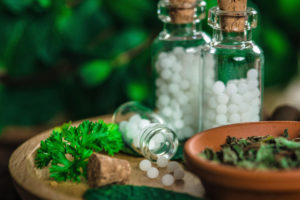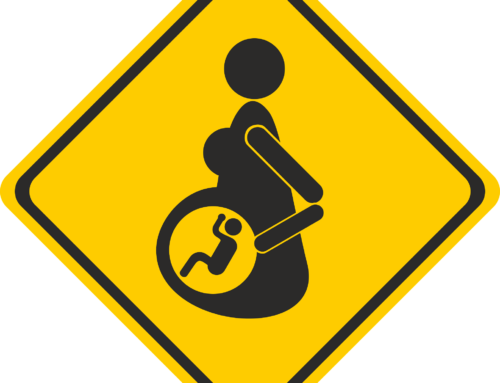In a world of rising medical costs, disease rates, and opioid epidemics, there is a safe, effective, and proven solution: Homeopathy.

Homeopathic globules in small bottles with mint leaves, homeopathy concept
Just a century ago, there were 22 homeopathic medical schools, 100 homeopathic hospitals, and over 1,000 homeopathic pharmacies. Boston University, Stanford University, and New York Medical College all taught homeopathy.
The evidence remains documented in studies, even after the Flexner Report — officially known as Medical Education in the United States and Canada —was published in 1910. The report was an attempt to align medical education under a set of norms that emphasized laboratory research and the patenting of medicine. The report was funded by John Rockefeller and Andrew Carnegie, among others, in an attempt to eliminate homeopathy as its competition.
Fast forward one hundred-and-nine years to 2019, and witness that homeopathy is in danger of going underground due to the effort by the medical industry, led by the FDA, to bury it once and for all.
The extinction of homeopathic practitioners, desired by many, has not occurred yet, because of their tenacity and creative efforts to spread their knowledge, and also because homeopathy is an open code science accessible to scholars, wise men and women, who work to deepen the knowledge of homeopathy. – Felipe Cardenas Tamara, homeopath
On December 18, 2017, the U.S. Food and Drug Administration (FDA) issued a draft guidance proposing a new, risk-based enforcement approach to drug products labeled as homeopathic. This policy guidance is more vague for manufacturers in its enforcement approach than the current guidance for homeopathic drug regulation and has the potential to limit the marketing of, and access to, homeopathic products that people now rely on.
Officials at the FDA claim that because the homeopathic drug industry has grown, they “need to better address situations where homeopathic treatments are being marketed for serious diseases and/or conditions but where the products have not been shown to offer clinical benefits. The approach also covers situations where products labeled as homeopathic contain potentially harmful ingredients or do not meet current good manufacturing practices.”
The details of the attack of homeopathy by the FDA can be found in my July 2018 blog. However, for those who claim that homeopathy has not been studied, they only need look at the long trail of evidence, beginning in 1831, when Samuel Hahnemann prevented and treated cholera during the 1831 Asiatic cholera epidemic with three main remedies. Accounts can be read in Cure and Prevention of Asiatic Cholera.
Studies and provings continued to be documented from India to South America and around the world. An impressive list can be found here. The disinformation about homeopathy proves one thing is true; that homeopathy is a threat to western medicine, not only because it is growing in popularity but also because it offers an inexpensive and safe remedy that works.
Leptospirosis Epidemic of 2007
As new disease epidemics reveal themselves, homeopathy is the answer, as it proved to be in late 2007, when the Cuban government rapidly distributed a homeopathic nosode (a remedy prepared from a disease component) of four leptospirosis strains to 2.3 million people at high risk of infection from an annual leptospirosis epidemic. In one of the largest studies of its kind, the remaining population of 8.8 million went untreated. Within weeks, the treated provinces had an 84% decrease in disease incidence while the numbers of those infected in untreated provinces continued at expected historical levels. The intervention was “strongly associated with a drastic reduction of disease incidence resulting in complete control of the epidemic.” The protective effect continued into 2008 with an 84% reduction in leptospirosis cases for the treated areas though no further prophylactic had been given. Leptospirosis infections in untreated areas increased by 22%.
Interestingly enough, the death rate of Spanish-flu patients treated with allopathic medicine was almost 30%, while the death rate for those treated homeopathically was 1.05%. Gelsemium was the remedy most commonly used; and yet the FDA, if it had its way, would remove this remedy without any hesitation or remorse whatsoever.- Scott Tips , attorney, international business law and litigation
Homeopathy is a holistic approach, based on provings. A proving is the testing of a potentized substance, or remedy, to find out which symptoms that substance is capable of producing, and hence curing. By using substances that are highly diluted, homeopathy triggers the body on a subtle level to heal itself on multiple levels; emotional, spiritual, and physical.
Homeopathic remedies offer a safe and natural alternative to synthetic drugs whose purpose is merely to suppress symptoms. Homeopathy can dramatically improve detoxification pathways, especially in people dealing with an MTHFR defect, which results in a reduced ability to eliminate toxins and metals. In a diagnosis of PANDAS, of which most doctors are unaware, homeopathy is one modality that offers solutions. The list goes on and on.
Homeopathy Proven
Homeopathy has proven itself, time and time again. Those who fail to understand how homeopathy works, who claim that “1800 studies later, homeopathy does not work,” choose not to understand that Nature cannot be studied in a lab, but it can be described as a healer. However, you cannot convince those who do not wish to be convinced.
As vaccine injuries are expected to rise under new vaccine mandates around the world, homeopathy will also rise as the antidote, even if it is driven underground. However, just as plants of Nature reseed themselves underground in the Fall, so too will homeopathy take root and be ready to rise again when the time is right. The beauty of Nature is that healing naturally happens wherever life exists. To think otherwise is to choose ignorance.







